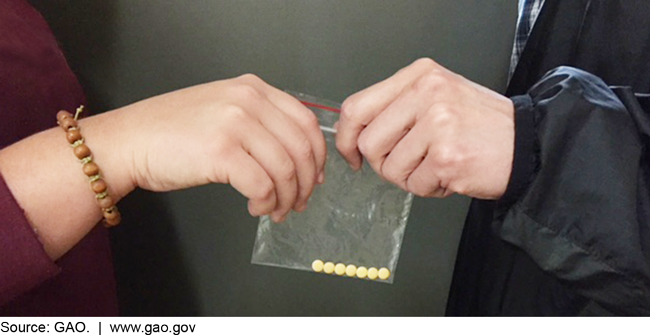Adolescent and Young Adult Substance Use: Federal Grants for Prevention, Treatment, and Recovery Services and for Research
Fast Facts
About 16 percent of adolescents and 38 percent of young adults used illicit substances in 2016. Most young adults who develop substance use disorders begin using in adolescence.
There are federal grants that fund drug addiction treatment for adolescents and young adults. But most of the stakeholders we talked to believed that there are too few studies about drug addiction treatment for adolescents, too few providers to treat these patients, and too few services to sustain their recovery.
Federal agencies are working to address these shortages, including a new grant to expand access to recovery services for adolescents and young adults.

Photo of two young people exchanging controlled substances.
Highlights
What GAO Found
GAO identified 12 federal grant programs within three federal agencies that funded substance use prevention, treatment, and recovery services in fiscal year 2017 and targeted adolescents' and young adults' use of illicit substances such as marijuana and nonmedical use of prescription opioids. The three agencies included the Department of Health and Human Services (HHS), the Office of National Drug Control Policy (ONDCP), and the Department of Justice (DOJ). While the Department of Education (Education) has grant programs that can fund prevention services for adolescents, they do not specifically target such services.
- Eight programs targeted substance use prevention. In total, they had 1,146 active grantees in fiscal year 2017 and provided about $266 million in awards that year.
- Four programs targeted treatment and recovery services. In total, they had 57 active grantees in fiscal year 2017. Two of the 4 grant programs awarded about $23 million in funding in that year (the other two awarded funding in prior years).
In addition, other grant programs beyond these 12 also fund substance use prevention, treatment, and recovery services across age groups, but are not specifically targeted to adolescents and young adults.
HHS's National Institute on Drug Abuse (NIDA)—the agency that is the primary funder of research on illicit substance use—also had 186 active grant-funded research projects focused on substance use prevention, treatment, and recovery among adolescents and young adults as of October and November 2017.
- Most of these research projects—126—were examining prevention, 45 were examining treatment, 4 were examining recovery, and 11 were examining a combination of research categories.
- In total, these 186 research projects received about $61 million from NIDA in fiscal year 2017.
Most of the 20 stakeholders GAO interviewed identified gaps in services for adolescents and young adults, including insufficient access to recovery services and a shortage of treatment providers, and described financial and other reasons that likely contribute to these gaps. Federal agency officials GAO interviewed agreed that these gaps exist, and described grant programs and other efforts to help address them, such as a grant program that HHS established in 2018 to expand recovery services for these age groups. Stakeholders also identified gaps in research, such as too few treatment studies with adolescent participants, and described reasons for these gaps, including too few federal grants focused on adolescent research. NIDA officials agreed that these gaps exist, and stated that NIDA had eight grant opportunities (as of May 2018) that focused on these age groups or included them as a population of interest, three of which were new in 2018.
Why GAO Did This Study
According to the Surgeon General, adolescence and young adulthood are critical at-risk periods for illicit substance use, and such use can harm the developing brain. Congress included a provision in law for GAO to review how federal agencies, through grants, are addressing substance use prevention, treatment, and recovery among adolescents and young adults.
Related to prevention, treatment, and recovery targeting adolescents (aged 12 to 17) and young adults (aged 18 to 25), this report describes (1) grant programs to provide services; (2) NIDA grant-funded research, and (3) gaps stakeholders identified in related services or research.
GAO selected four agencies to review—HHS, ONDCP, DOJ, and Education—the key agencies that fund grant programs for services for adolescents and young adults. GAO analyzed documents on grant programs and on research funded by NIDA. GAO interviewed officials from the four agencies and 20 stakeholder groups (including advocacy and education, and research organizations, as well as a non-generalizable selection of state substance abuse, education, and judicial agencies in four states) about gaps in services or research and agency efforts to help address them. States were selected for variation in geography and overdose rates.
HHS, DOJ, and ONDCP provided technical comments on a draft of this report, which GAO incorporated as appropriate.
For more information, contact John E. Dicken at (202) 512-7114 or dickenj@gao.gov.
